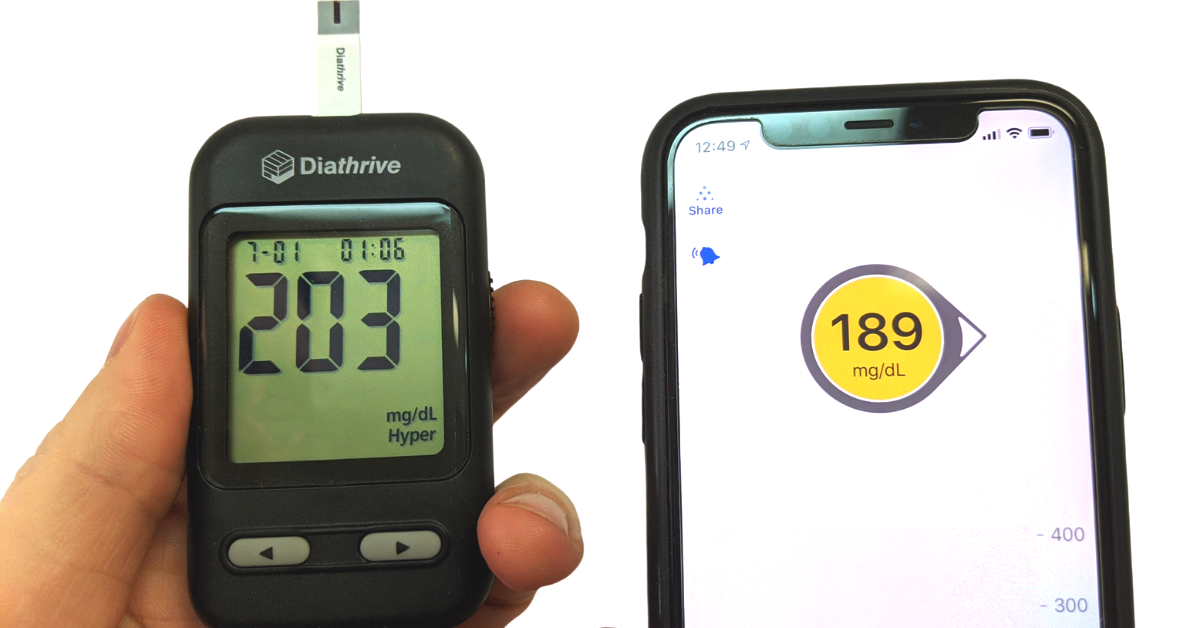
If you have a CGM, there are still times you will need to check your blood sugar with a test strip. Here's why you should keep a blood glucose meter and test strips on hand.
I remember when I got my first CGM (constant glucose monitor). Even with good health insurance, the out of pocket cost for this new blood glucose monitoring system was high. But it was so worth it! The *real-time blood sugar information changed the whole game for me.
CGM is a device that takes a blood sugar reading every 5 minutes from an electrode embedded in the user’s skin. The electrode reads interstitial fluid and translates into equivalent blood sugar. With readings coming in so frequently it is much easier to see how everything from food to stress is affecting my blood sugar. I can see when my blood sugar is high, low, in normal range, and even when it is rising or falling before it even reaches the highs and lows. Then I can take action before there’s even a problem. It’s proactive instead of reactive.
The *real-time factor is interesting. There is a delay of 5-10 minutes from when glucose is in the blood to when it affects interstitial fluid, especially during times of rapid increase or decrease. So, when my blood sugar is dropping rapidly, for example, a glucose test from blood will show a more real-time, accurate number than my most recent CGM result. But regardless of the delay, I know to check with a blood test because my CGM told me that blood glucose is going down quickly, allowing me to take action before urgent lows strike. That doesn't mean CGM isn't accurate. I've been very happy with the accuracy of my CGM. The drastic improvement in my A1c within the first 3 months of getting mine was all the evidence I needed of its value and accuracy.
Early CGMs to hit the market required calibrations. I needed to check my glucose levels every 12 hours with a test strip and input the result for the CGM device to adjust in order to improve accuracy and ensure my CGM readings are staying close to actual real-time blood sugar. So, for someone who checks blood sugar with a glucometer 6+ times per day, that reduction to 2 times per day is already a win!
Fast forward to more recent advances in CGM. Most newer CGMs don’t even require calibrations. Even the marketing of these devices loves to tout, “No more finger sticks!” Sounds amazing! And, honestly, I hardly ever need to check with a test strip! But, the marketing message didn’t hold true. In fact, I think it is a dangerous message.
4 reasons to keep test strips on hand if you use CGM
After getting my upgraded model of CGM that claimed no more finger sticks would be needed, It didn't take long for me to realize that wasn't the case. So I picked up some of the classic diabetes testing supplies: my blood glucose meter and some test strips. Here are four reasons why I decided I needed these diabetes supplies.
Reason one: Keep your CGM in check. It’s not just about the delay. It’s about the stability. However infrequent, I have absolutely had times when my CGM number didn’t seem right. When using a test strip, I found the steady line of non-fluctuating blood sugar was off base. Luckily, my CGM allows calibration (some don’t even give the option), even though it claims I don’t need to stick my finger any longer. The calibration will usually help guide the CGM back into a proper range.
Reason two: CGMs get squirrelly! CGM results can be easily viewed on a reader device as a graph with simple data points. Now and then, something interferes, whether the age of the sensor, a transmitter error, or the reader device itself. I’ll occasionally start seeing gaps in data; several readings, then no readings, then readings will pick back up but start in a much different place than they left off. In those moments, while waiting for things to get back to normal, a quick blood glucose check with a test strip will give me the info I need.
Reason three: CGMs fail. Sensors are supposed to last for a specified amount of time (7 days, 10 days, up to 14 days, depending on the CGM). But they fail. I’ve had many fail early. And when a new sensor is inserted, there’s an hour or two required for the new sensor to warm up. If you need to know your blood sugar during that time, you’ll need a test strip.
 Reason four: In case of supply issues. Prescriptions and insurance is required in order to get my hands on CGM. Even then the cost is high. So, before I reorder sensors or a new transmitter, I have to evaluate whether I can afford the next round. Adding to the issue, insurance dictates how many sensors they will cover at a time. There have been times when I had to wait a month to get the supplies I need. That’s when the “no finger sticks” message is obliterated by the harsh reality. I need to know my blood sugar. I need test strips on hand. And, if I were beholden to my insurance company in that sort of emergency, I’d have to dish out extra money and expend more energy explaining and fighting for what I need. And, aside from my own financial variable, there have been times when supply was simply not available. I, and others I know, have been on waitlists to get a refill of CGM supplies.
Reason four: In case of supply issues. Prescriptions and insurance is required in order to get my hands on CGM. Even then the cost is high. So, before I reorder sensors or a new transmitter, I have to evaluate whether I can afford the next round. Adding to the issue, insurance dictates how many sensors they will cover at a time. There have been times when I had to wait a month to get the supplies I need. That’s when the “no finger sticks” message is obliterated by the harsh reality. I need to know my blood sugar. I need test strips on hand. And, if I were beholden to my insurance company in that sort of emergency, I’d have to dish out extra money and expend more energy explaining and fighting for what I need. And, aside from my own financial variable, there have been times when supply was simply not available. I, and others I know, have been on waitlists to get a refill of CGM supplies.
Luckily, I don’t need my insurance company involved to get test strips. I don’t need to worry about a copay, prescription, or any insurance red tape. I don’t need to wait for approvals, fight for coverage, or answer to anybody but myself. I don't need to worry about supply shortages. Using Diathrive is my hassle-free, affordable solution. I get what I need, when I need it. Take a look at what Diathrive offers and keep yourself stocked for when you need test strips. CGM + glucometer = fully prepared blood sugar monitoring.

